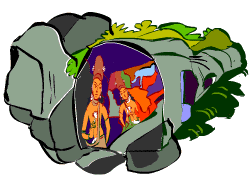I could feel it moving and as I heard the soft humming of its engine, I shut my eyes tight.

Cave Art at its Best [Illustration by Shinod AP]
After a few hours which seemed like eternity, I was glad to be on firm ground. Once in Aurangabad, we started on our first sightseeing trip to the famous Ajanta caves.
Situated about 106 kilometres from Aurangabad, the caves can be approached only by road. A lot of buses ply between Aurangabad and the caves as there is always a steady tourist flow.
We boarded a charted bus and began fighting over a window seat. Finally, both of us ended up getting seats next to the aisle. As we ridiculed each other over the seat fight, we caught the first glimpse of the magnificient caves.
Standing tall in front of us were 30 caves, cut into the steep face of a horse shoe-shaped rock. Dating back to the 4th and 9th century A.D., the caves contain a rich treasure of paintings that have been painstakingly preserved over the years.
Besides multicoloured murals, depicting a large range of subjects from battlefields to boudoirs, sailing ships to city streets and animals to snow-capped mountains, the cave walls are also adorned with sculpted images of the Buddha.
When you go visiting the Ajanta caves, remember to hire a taxi or auto rickshaw for a day. Since, it can get quite tiring if you try doing all the caves on foot.
And if you want to enjoy the site in anything close to its original serenity, avoid visiting it on a weekend or a public holiday. It will take quite a fertile imagination to picture Buddhist monks filing softly around the rough stone steps, when riotous schoolkids and holidaymakers like us are clambering all over the place.
The best seasons to visit are either during the monsoons, when the river is swollen and the verdant gorge reverberates with the sound of the crashing waterfalls, or during the winter months between October and March.
At other times, the relentless Deccan sun beating down on the bare south-facing rock can make a trip to Ajanta a real endurance test. Whenever you come, bring a hat, some shades, a strong flashlight and plenty of drinking water.










